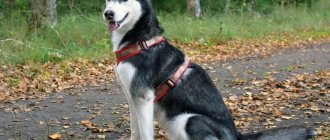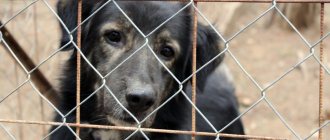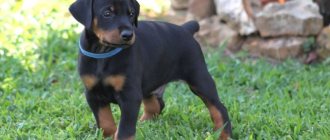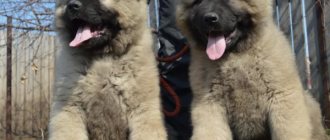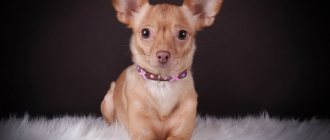Dogs normally have four toes on their hind feet. They allow the body to balance while standing and in motion. The animal's fifth toe is called a dewclaw, vestigial or wolf's claw. Unlike the main ones, it has 1–2 phalanges, is loosely attached to the bone or suspended on the skin. If the appendage causes concern to the animal, veterinarians advise amputation of the dog's dewclaw.
Meaning of dewclaws
Dewclaws in a dog are atavism (a sign of the existence of a wolf in the family). At this stage of evolution, the puppy simply does not need the rudiment. Although, there are some dog breeds in which the 5th finger indicates purebred origin:
- French Shepherd;
- Pyrenean dog breed;
- German husky;
- briar
Rudimentary toes in dogs can appear on both the hind and forelimbs. The structure of the rudiment on the front and hind legs is different:
- The dewclaw of the hind limbs does not have a phalanx, but is attached to the skin. Therefore, the rudiment is often injured.
- The dewclaw on the front legs of dogs has phalanges that are well connected to the bone. Therefore, the rudiment can interfere with the dog when walking and running.
Features of the structure of a dog's paw
Normally, a dog's paw consists of four toes with soft pads and claws. The pads have a shock-absorbing function, they reduce the load when running and walking. Their skin is rough, which provides the animal with stability on slippery surfaces. In working dogs, due to prolonged exposure to fresh air, the surface of the pads becomes rough.
Dewclaws in dogs – pathology or normal
When walking, the main load falls on the dog's fingers. They cannot move them because the space between the fingers is too small.
Depending on the shape of the paw there can be three types:
- Felines are distinguished by their compact size and round shape. These paw shapes are typical for dogs of large breeds, for example, Spanish mastiff and husky.
- Hare feet are elongated, with long ring fingers. This structure allows you to quickly develop speed.
- Webbed - this shape is typical for hunting dogs, for example, the Jack Russell Terrier.
Dewclaws in puppies raise many questions among owners.
Structure of a dog's paw
Do I need to remove the rudiments?
Dewclaws of the hind limbs are not considered a pathology and it is not necessary to remove them. Veterinarians recommend operating on puppies to avoid possible complications:
- injuries while walking, running;
- inconvenience in caring for the dog: cutting, combing; bathing;
- ingrowth of the nail into the skin.
It is mandatory to remove a finger in case of diseases of the dog’s paws. Such diseases include:
- necrosis – tissue death;
- osteosarcoma;
- gangrene;
- osteomyelitis;
- dewclaw injury.
There is also a group of dogs that will have to have their dewclaw removed:
- Hunting breeds. Due to the rudiment, it becomes difficult to move through thickets and forests. The fifth finger will simply cling to branches and grass, which can injure the animal.
- Show dogs. If a dog is being prepared for a show, then removal of the rudiment is mandatory during puppyhood. But there is an exception: it is forbidden for the Pyrenean Mountain Dog and Biard to remove the rudiment before the exhibition. The appearance of the 5th finger indicates their purebred.
Read Causes of adenovirus infection in dogs: signs and methods of treatment
To reduce the risk of injury, veterinarians recommend removing dewclaws from puppies under one week of age. During this period, the puppy will not feel severe pain, and the recovery process will go quickly.
Reasons for the appearance of an extra finger
How many toes does a cat have on its hind and front paws?
The appearance of an extra toe on a dog's paw is called atavism. This phenomenon means that the animal's body contains characteristics of all the species that were involved in breeding. The fifth rudiment is a sign left over from a close blood ancestor; it indicates a connection with the wolf.
For your information! Most hunting breeds were crossed with wolves, hence the origin of the fifth toes. For certain breeds this is a natural phenomenon.
Scientists still cannot answer why in one and the same breed one puppy has a dewclaw, and the second does not. This is a dominant trait: if a male has five fingers and a female has four, then the puppies from such a marriage will have five fingers. This phenomenon is most often observed in German Shepherds.
An additional vestige indicates a connection with wolves
Could there be as many as six of them?
There are situations when puppies have two dewclaws at once. The owner must decide for himself whether they need to be removed. Everything will depend on whether they interfere with the animal.
How does amputation occur?
Some dog owners, instead of seeking professional help, carry out the amputation themselves. But it would seem that the simplest operation can only harm the puppy: the owner will simply remove the rudiment incorrectly and in adulthood the pet will have to resort to removing the dewclaw again. If amputation is carried out without pain relief, the puppy will develop pain shock and the animal may die. Also, the puppy may develop an allergic reaction to the anesthesia; due to swelling of the larynx, the pet may die.
Veterinarians recommend removing the fifth toe in puppies when the risk of complications is minimal. A one-week-old puppy has a weak pain threshold, so amputation of the dewclaw is easier to tolerate than in adult dogs. The operation is performed under local anesthesia or general anesthesia, depending on the age of the pet. Surgical intervention is easily tolerated and does not pose a threat to the life of the animal. In adult dogs, the rudiment is removed after injury.
Fixation of the patient
Before amputation of the rudiment begins, the veterinarian fixes the animal. The method of immobilization depends on the age of the dog:
- A puppy up to a week of age is fixed by the owner. The breeder simply holds the pet tightly in his arms.
- An adult dog is immobilized on the operating table. The doctor selects the most comfortable position: on the left side or abdominal position.
If the animal is poorly secured, then during the removal of the rudiment, the veterinarian may involuntarily inflict a cut wound with a scalpel.
Anesthesia
The anesthesia procedure is selected for dogs depending on their age:
- Puppy. If the pet is less than a week old, the veterinarian will administer local anesthesia. The puppy is first injected with novocaine using the infiltration method.
- Adult dog. For adult dogs, amputation of the fifth toe is performed under general anesthesia.
Read Allergies and Labradorite: effective ways to treat the disease
If the puppy did not have time to remove the rudiment before the age of one week, then the operation is postponed. In this case, the veterinarian will resort to surgical intervention when the dog reaches 12-16 weeks.
Progress of the operation
Removal of the 5th toe in puppies is carried out in a veterinary clinic where sanitary standards are observed. Before removing the vestige, the operating room is disinfected and instruments are sterilized. The course of the operation depends on the attachment of the rudiment:
- If the rudiment is attached to the skin, the veterinarian removes it using scissors and a scalpel.
- If the rudiment is connected to the bone by a phalanx, then the veterinarian will remove the second phalanx with a scalpel.
After the operation, the puppy may notice some bleeding. After stopping, the dog is given stitches and a sterile bandage. To prevent the puppy from developing stress, the doctor can sew the wound with self-absorbable threads - catgut.
Interesting! The operation to remove the rudiment is considered an easy manipulation. And the whole procedure lasts no more than 20 minutes.
Rehabilitation
After surgery to remove the 5th toe from a dog, the owner must carefully monitor the condition of the wound. The dog must be in a clean room where wet cleaning is carried out daily. Every other day you will have to change the bandage using antiseptic agents. Simple manipulations will protect your pet from infection through an open wound.
A week after the rudiment has been removed, the puppy needs to be shown to a veterinarian. If the stitches are applied with catgut, they will dissolve on their own. If the dog received stitches during the operation, then on the 8th day after the manipulation, the specialist removes them.
Important! If the owner notices suppuration during the dressing, the dog becomes lethargic, inactive, and the temperature rises, then it is necessary to immediately visit a doctor to begin treatment. There may be an infection in the wound. Lack of veterinary care can lead to the death of the animal.
Should my dog's fifth claw be removed?
Many dog breeders don't know whether to remove the toe or not. If your dog does not participate in exhibitions and does not qualify for certain breed standards, then in this case you do not have to undergo a painful and unpleasant procedure. You should contact a veterinarian in the following cases:
- The vestigial finger often becomes inflamed;
- It interferes with the dog when jumping or running;
- You want to achieve a high breed standard.
The wolf claw is removed through surgery. Most often, the procedure is performed on puppies no older than seven months. It is done using local anesthesia. At this time, the owner can stay close to his pet, thereby calming him down.
After the procedure, the veterinarian applies stitches. Caring for seams is not difficult. It is enough to treat the surface of the wound with alcohol or other antiseptic drugs. During the first days, you need to carefully monitor the dynamics of healing. The wound should be clean. If there are abscesses, suppuration, or excess cerebrospinal fluid in the suture area, then it is worth contacting a veterinarian for an additional preventive examination.
Try to change your bandages as often as possible. After the operation, the dog returns to normal condition in about a week. A wolf claw can be removed on one or both paws. Most often, dogs of large massive breeds have problems with an extra toe. In any case, it is better to consult with an experienced veterinarian before carrying out the procedure.
Do you want to consult with a specialist on this issue?
You can see the prices and services of the veterinary clinic
View prices for all services
To contact the clinic, contact us in the most convenient way:
+7+7
Make an appointment
Care for dewclaws
If the breeder decides not to amputate the 5th finger of his pet, then he must properly care for him. All procedures are carried out in the same way as with the animal’s ordinary fingers: it is necessary to trim the claws in a timely manner and ensure that the dog does not injure the rudiment. But, if the claws grow incorrectly, dig into the skin, and cause discomfort to the dog, then veterinarians recommend thinking about the procedure for removing the dewclaw.
Read When and what vaccinations to give to puppies up to one year old (table)
Whether or not to amputate a puppy's 5th toe is the owner's decision. Before making a decision, the owner should think about the animal’s lifestyle: whether the owner can care for the 5th toe without injury. Grooming, bathing or combing the animal should be done with extreme caution. An extra finger should not interfere with walks and exhibitions.
Main causes of toe fractures in dogs
An extra claw on the hind paw most often interferes with the animal. It is mobile because it is not held together by cartilage and muscles. Because of this, injury often occurs. The dog cannot retract such a claw; he constantly clings to sticks, branches, bushes, and foliage. If the pet is active, this physiological phenomenon causes him a lot of inconvenience. Therefore, it is recommended to remove the extra finger.
It is not uncommon for dogs to break their appendix for various reasons. Often injuries occur due to the fault of the owners themselves. For example, a heavy object was dropped on the dog’s paw or stepped on, or pinched by a door. Most often, small breed dogs suffer from this.
Injuries that result in finger fractures occur in overly active pets. This is especially true for young puppies who actively run around in nature. They can get caught on a bush, fall into a hole, or get their paw caught between the roots. When you try to pull it out, your finger may turn, which will lead to a fracture.
Finger fractures cause severe pain to your pet
Dogs often suffer fractures during play or fighting due to bites. Even when just playing, dogs can bite each other's paws, which can lead to fractures.
